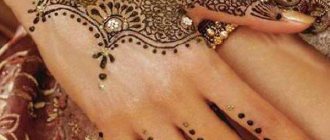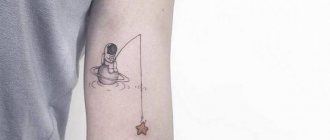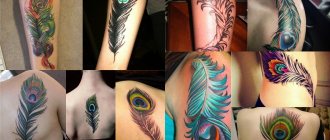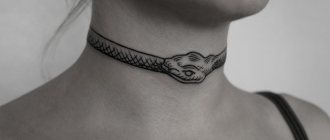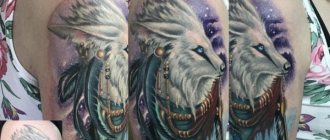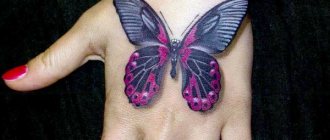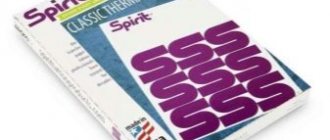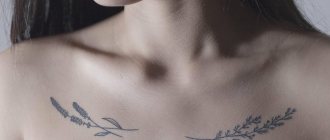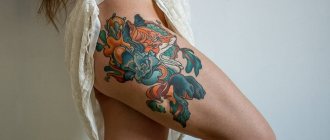What are the advantages of tattoos made from natural materials?
- Henna tattoos are short-lived and can always be replaced with a new one or removed completely.
- The drawing can be applied independently on any part of the body convenient for you.
- The process of applying a biopattern is absolutely safe.
- Does not lead to any damage or infectious inflammation.
- Affordable price.
- Minimal possibility of allergic reactions.
Benefits of temporary henna tattoo
- You can always change a henna tattoo for another, constantly change designs and patterns, and when you get completely tired of it, you can completely get rid of it without much difficulty. If there is a pattern that you never want to wash off, then it can always be converted into a permanent one.
- Applying a temporary tattoo is an absolutely safe process that cannot lead to inflammation or any infections. On the contrary, it is believed that henna has a beneficial effect on the skin, enriching it with some beneficial substances.
- To remove such a tattoo, you will not have to resort to operations and other terrible methods of reduction; everything is extremely simple, and the price of a temporary tattoo is much lower.
What do you need to know to draw henna yourself?
First, it is important to remember which henna is suitable for a tattoo. If you want to get a darker and more saturated shade of the design, then the powder must be mixed with black graphite; to obtain colored shades, the not too rich palette of henna can be diluted with other natural dyes.
The original color of such paint can vary from red to dark burgundy; by the way, you will see the final color of your tattoo only 24 hours after application, during which time the paint can change in shade several times. In order for the drawing to be as bright and clear as possible, oddly enough, it must be applied with fairly thick and rough lines.
Before you start drawing, you need to prepare henna paste for a tattoo in advance; it is best to do this about a day in advance, this is the only way to get high-quality material for work.
When choosing an area of the body where a temporary tattoo will be applied, it is important to consider that this technique looks most impressive on the back of the arm or hand, on the foot and instep of the leg, as well as on the stomach around the navel. If you decide to take up such a difficult, but very interesting activity, then it would be better to practice on simpler areas of the body - well, the arms or legs - the patterns there are clearer and brighter.
You should also take into account the fact that before applying the design, the area of the body being used must be completely freed of hair, otherwise, after the tattoo disappears, you will have to undergo unexpected depilation. The fact is that the dye eats into the hair very strongly, and if it has already come off from the body, then most likely not from the hairs, creating a very careless and unflattering sight.
Stages prior to drawing
In order for a henna tattoo made at home to please you with its beauty, to lie uniformly and beautifully, you should adhere to certain rules:
- A few days before applying the pattern, avoid exposure to ultraviolet rays on the tattoo area.
- Scrub the skin to remove dead particles, thereby increasing the time the mehendi stays on the body.
- Before the session, wash your skin with soap and water.
- Remove even the smallest hairs, otherwise they will quickly absorb the coloring pigment.
Exquisite henna designs – beauty through the ages!
In India, mehendi has a sacred meaning. It is believed that a henna design made with love is the strongest amulet. Only experienced and benevolent craftsmen were trusted to apply patterns on the skin, because no one wanted to wear a destructive symbol on themselves for several weeks!
Traditional tattoos are drawn freehand. Creating a charming intricacy of lines, craftsmen use many basic patterns and try not to make exact copies so that the final mehendi is unique.
If you go to a salon for a temporary tattoo, in 90% of cases the design will be done using a stencil.
Tattoos can be performed with equal quality both at home and in a tattoo parlor. The basic pattern is chosen by the client, and the master creates a unique masterpiece based on it. The drawing disappears completely in just a month, so most people willingly agree to improvise.
High-quality mehendi is performed by:
- Natural henna for body painting Experienced artists try to paint exclusively with brown henna, which does not contain dyes. Black and white patterns are rare because they often provoke allergic reactions. Masters prefer to order powder from India or Turkey.
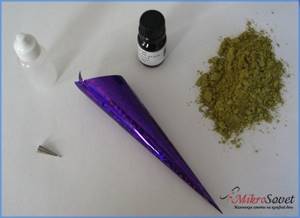
- Fresh henna The composition of the dye, in addition to henna powder (henna), may include medicinal oils that are absorbed into the skin and strengthen the immune system. The prepared solution is stored in the refrigerator for no more than 3-4 days.
- Experienced professionals You can only trust your body to professionals. Have you decided to make a henna design? If you are seeing a master for the first time, then studying the portfolio will not be enough. For the first time, get a temporary tattoo in a place that is easy to hide with clothing (legs, shoulders, stomach, back).
- Drawing on traditions Tattoos are usually performed in Indian and Egyptian, Turkish and African, Celtic and Slavic styles. When applying a specific pattern, it is important to ask the artist about its meaning. In the salon, the drawing is often done in the European style, most often using a stencil.
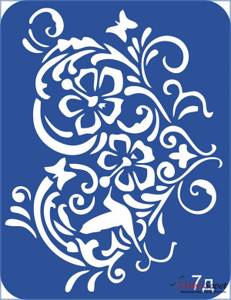
Tattoo on the arm - femininity embodied
Women prefer to paint their hands from the elbow to the fingertips. Mehendi serves as a kind of replacement for bracelets and rings.
The skin of the wrists is very thin, so it lasts a long time. But it comes off instantly from the palms and fingers, especially from the hands of housewifely ladies.
- Patterns-bracelets A henna pattern, located horizontally, seems to encircle the hand with a weightless bracelet. A closed pattern symbolizes concentration on the inner world, an open one (not connected into a single whole) - an outward focus. Bracelets serve as amulets, bring good luck in love and help fulfill cherished desires.
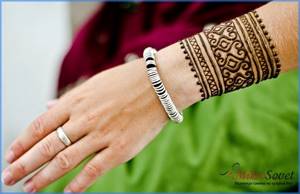
- Elongated mehendi Decorations located along the veins are designed to strengthen the body, set the mood for fruitful work and contribute to the development of creative abilities. Patterns in the form of “dream catchers”, floral and geometric themes are popular.
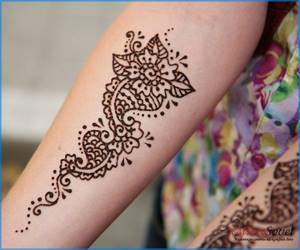
- Stylized images of totems Men usually prefer the “animal style” and agree to wear mehendi only on their shoulders. Stylized images of birds (owls, seagulls, phoenixes) and wild animals (lions, tigers) are extremely popular.
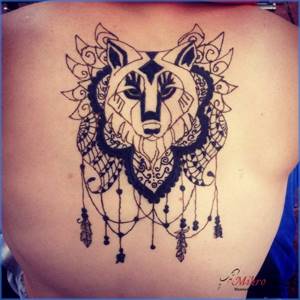
Drawings on the body - endless scope for imagination
The back, stomach, décolleté and neck – there is room for a mehendi master to roam. The temporary pattern in this area lasts less than on the hands - the skin is rougher, so henna is less absorbed into the epithelium. Not only ethnic motifs look stylish, but also cool inscriptions, stencils and stamps.
- Women prefer designs with smooth lines that emphasize the curves of the body.
- Men should emphasize their muscles and choose geometric patterns and large temporary tattoos.
Pattern technique
So, how to make a henna tattoo? The preparatory stage has been completed, you can begin the actual application.
- Choose your favorite pattern. If you don’t have a particular predisposition to drawing, you can purchase a ready-made stencil in advance, with which even a beginner can get a beautiful mehndi.
- Draw a drawing using a marker or pencil
- To apply the composition, prepare a cone-shaped bag, brushes, toothpicks, anything that will help you apply lines of varying thickness. If there is no such package, you can use a regular syringe without a needle.
- The layer of paste laid out should not be thin, about 2-3 mm. Try to immediately remove unnecessary or sloppy lines with a cotton swab dipped in lemon juice.
- After completing the main procedure, you need to wait for the pattern to dry completely, which will take several hours.
- After the required time has passed, you need to scrape off the excess henna with a regular dry cloth.
- Rub with lemon juice and oil to consolidate the result.
Freehand drawing
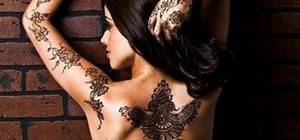
What will you need?
- Distilled water.
- Henna is not Iranian, natural.
- Mixing container (can be plastic).
- Sugar.
- Essential oil.
- Mixing spoon.
- Cling film.
To begin, pour a heaping teaspoon of dry henna powder into a container, add half a teaspoon of sugar, then add water a little at a time, stirring the mixture well to dissolve the sugar and until you get the consistency of sour cream. Add a few drops of essential oil to the resulting mixture. The mixture should be slightly viscous and thick. For better dissolution, the mixture should be covered with cling film and left for 2 hours.
A pre-prepared cone made of thick paper or film is suitable for applying the design. A jar with a cone-shaped lid is also ideal as a tool. You can draw either on your own or by asking someone you know who draws beautifully or has good aesthetic taste.
Prepare in advance the design that you want to depict on your body. Keep in mind that every flower, animal or hieroglyph has its own meaning. Some of them are a kind of talisman for a person. For example, animal designs in tattoos are designed to help owners develop their personal qualities. And images with flowers act as decoration for girls and carry a certain meaning. And additional elements add individual context to the tattoo.
Temporary tattoo using stencil
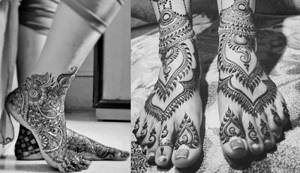
It is better to purchase a ready-made stencil, because the pattern will be even. In this case, errors are eliminated. In turn, when applying a drawing by hand, you can make a mistake and accidentally “smudge” the drawing. Another option if there are no ready-made stencils. For example, if you don’t have time to look for where to buy it, there is another option for a ready-made stencil for drawing. To do this, you need to apply a drawing on your hand with a pen in advance.
- Degrease the skin with an alcohol wipe.
- Paste the stencil onto the skin.
- Apply henna paste to the skin with a thin layer of 05.-2 mm. The paste is prepared in advance from henna and water. It is also possible to purchase ready-made paint. One bag or tube should be enough for several small drawings.
- The paint absorption time into the skin is from 40 minutes to 2 hours, the paint must dry completely.
- Carefully remove the stencil and the remaining dried paint layer.
- To make the design last longer, sprinkle it with lemon juice.
Indian art of body painting
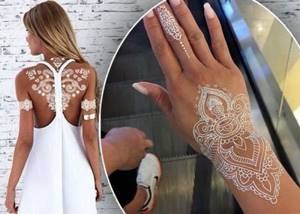
It's worth saying though. That the exact origins of its origin are not known with certainty. Because its origins can be traced back to Ancient Egypt. In those days, only representatives of noble strata of society were the owners of original and mysterious henna designs. Mehendi designs look beautiful not only on the arms and legs, but also on other parts of the body. Girls often choose small tattoos in Arabic or Indian style, where the emphasis is on floral motifs and flowing patterns.
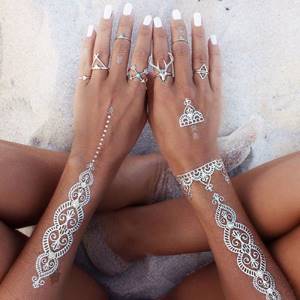
They say that mehendi is a song written with henna. In recent years, such an ancient tradition of decorating the body with henna has become a new trend all over the world.
Performing this technique with white henna looks very beneficial on tanned skin. So if you want to highlight your tan and leave an unforgettable impression of summer, you should definitely try painting with white henna.
Which part of the body should the tattoo be applied on?
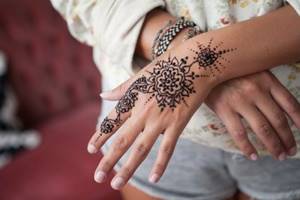
Tattoos on the legs: palms and calves are also very popular. For representatives of the fair sex with an ideal toned figure, temporary tattoos on the side, back, chest and even stomach will look very beautiful. This decoration lasts on the body from a week to a month. The option with white henna is much shorter in durability - only a day or two. Because it washes off with water. A temporary tattoo is ideal for photo shoots or seaside holidays.
You can learn more about the tricks and nuances of applying temporary henna tattoos from the video:
What can a drawing tell you?
Each element of the picture carries a certain meaning. The most basic ones are:
Lotus flower. Symbol of purity and innocence. Very often, a drawing is applied to those who have these qualities or want to return them.
Peacock. This symbol can often be seen among individuals seeking to know the truth, as well as those who are tired of life. A bright bird helps creative people to reveal and increase their potential.
Elephant. The drawn strong animal endows men with nobility and women with wisdom. For older people, the elephant is a symbol of longevity, and a sign of procreation for brides.
God Ganesh. The appearance of Ganesha is the body of a child and the head of an elephant. Such an image will help remove all obstacles in new endeavors, strengthen intuition and help restore childlike spontaneity and joy of life.
Methodology
There are several methods of painting on the body using henna - mehndi, mehendi. All of them originate from the countries of India and Indonesia. The advantage of such tattoos is that they look very beautiful, sophisticated and not provocative on the hands. In India, it is believed that hands decorated with henna tattoos have magical properties. Modern girls make openwork designs on their hands, which looks unusual and very beautiful.
If you are not afraid of experiments, then pay attention to the tribal henna tattoo. This is a drawing on the body in 3D effect. Not only women, but also men apply henna to their bodies. Popular places on the body where you can get a tattoo: lower leg, back, navel area, shoulders and forearms.
How to make a temporary tattoo?
In order for the tattoo to last as long as possible, first of all, the application site must be thoroughly degreased (for example, washed with soap and then wiped with alcohol). Then a few drops of eucalyptus oil are rubbed into the skin, which increases the drying time of the henna, and therefore enhances its effect. It is important to be sure that it does not cause allergic reactions in you; to do this, drop a few drops of oil on the crook of your elbow at night, and look at the result in the morning.
The next stage is drawing patterns. Of course, if you have never painted with henna before, then the first experience will be quite difficult for you; it is better to start with more or less simple sketches. For those who are completely unable to cope on their own, there is another way - using special design stencils to create a temporary tattoo.
Apply paint using a syringe or a special stick; you can first make a light sketch using a pencil or water-based felt-tip pen.
After the tattoo is finished, you need to wait 1-2 hours for the ink to absorb and dry, and then use lemon juice as a natural moisturizer.
How long does a henna tattoo last?
A tattoo made on the body with henna does not last long, but it gives a great advantage in quickly changing the image. It should be noted that you should not apply a tattoo to the same areas of skin. Although henna is an absolutely harmless dye, if you use it repeatedly in one place, you risk causing an allergic reaction to its solution. To ensure that a henna tattoo always pleases you and those around you, you should be imaginative when choosing where to apply it. Intricate patterns, appearing in different places each time, will surprise those around you and those close to you and will add mystery and style to your image.
In order for a henna tattoo to last longer and be of higher quality, depilation and skin peeling are first necessary. You should refrain from intense exercise, as the pattern may blur due to increased sweating.
After the henna design has been applied, it is recommended to treat it with almond or sesame oil. This method of care will help extend the life and give the tattoo gloss.

Preparation of henna solution to create a Mehendi pattern
Recipe No. 1
The following components must be available:
Henna powder for Mehendi solution in an amount of 25 grams;
One medium-sized lemon;
50 milliliters of strongly brewed tea (chifir);
One drop of tea tree oil.
In order to apply a mehendi design to yourself, you need to make the composition at home, first, you need to sift the henna, this is necessary in order to separate the larger and coarser particles. To do this, you can use silk as a sieve. The brewed tea must be mixed with freshly squeezed juice taken from half a lemon, then gradually add sifted henna powder and while stirring well, add a drop of tea oil. As a result of such manipulations, you will get a viscous, lump-free mixture. The resulting solution must be left to infuse for four hours.
Recipe No. 2
According to this recipe, you can get a significantly larger amount of the required solution from henna, which can be used to apply larger designs. The solution can be frozen and used again if necessary.
Necessary components for this solution:
One cup of dry henna;
Two sticks of instant coffee;
Two tablespoons of freshly squeezed lemon juice;
Five drops of eucalyptus oil;
Five drops of clove oil.
First you need to sift the henna. You need to dissolve coffee in 350 milliliters of water and then boil it until about half a cup boils away. Henna must be added gradually, and at the same time stir thoroughly at once, and make sure that no lumps form. Then add oil and freshly squeezed lemon juice. The result of preparation should be a viscous and not too liquid solution. If the mixture turns out to be liquid, then you need to add henna powder, and if it is thick, add water or coffee. Next, the resulting solution for mehendi should be left to infuse for two hours.
Recipe No. 3
Through a sieve, preferably a fine one, you need to sift the Indian henna. To obtain a fine powder, it is better to use a cloth. Then you need to add freshly squeezed lemon juice and mix everything very well. The mixture should be not too liquid and not thick, similar to puree. The container in which the resulting mixture is located must be covered with plastic wrap and left to infuse overnight. After this you need to add powdered sugar and more lemon juice. Then add more tea tree oil and leave for another four hours. Then, the mixture can be used to apply mehendi designs at home.

